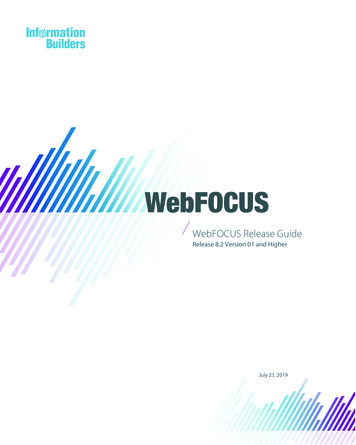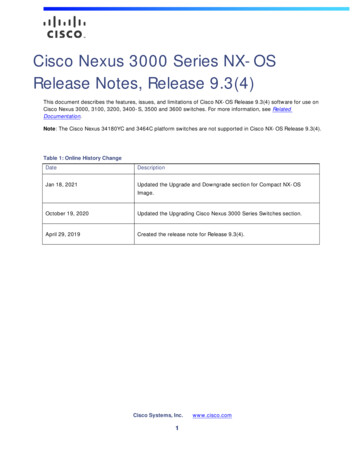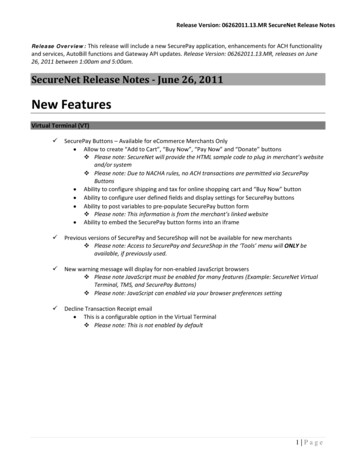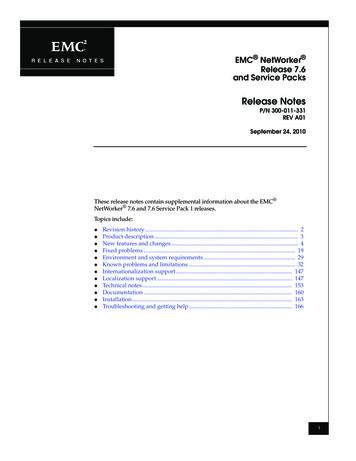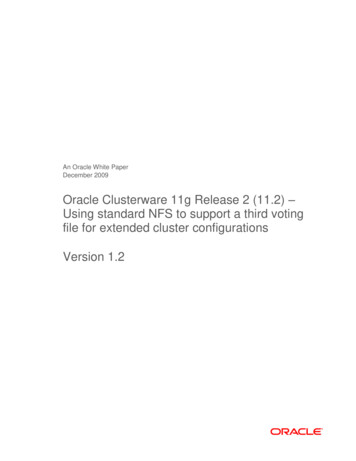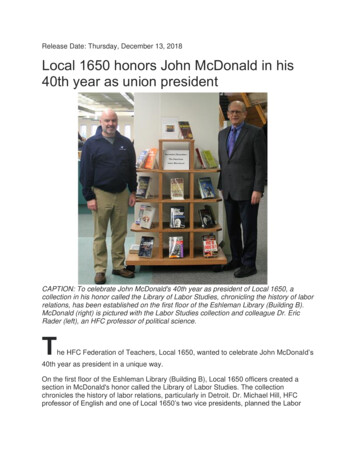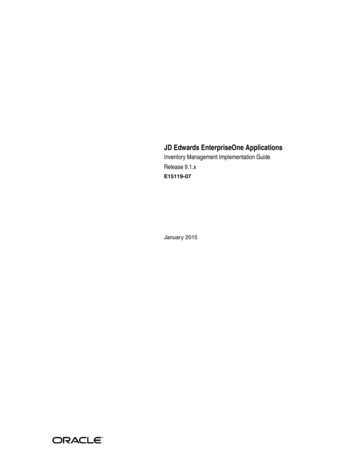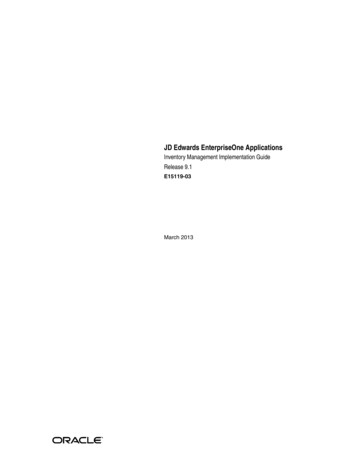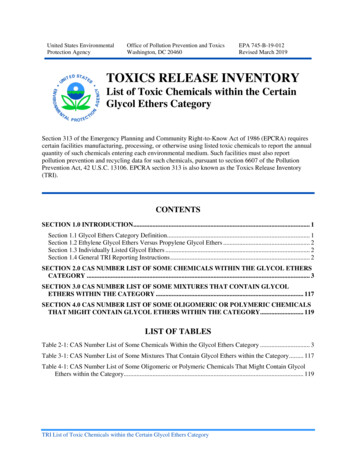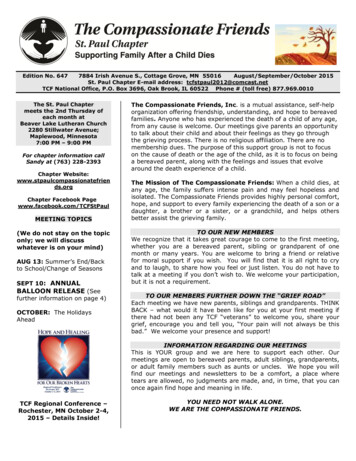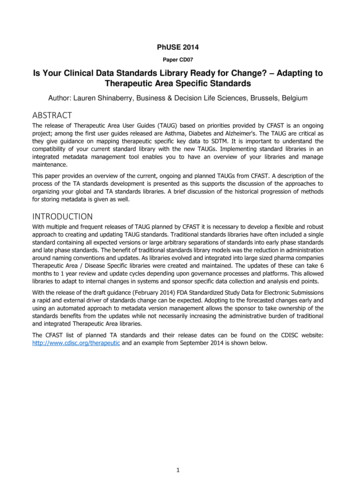
Transcription
PhUSE 2014Paper CD07Is Your Clinical Data Standards Library Ready for Change? – Adapting toTherapeutic Area Specific StandardsAuthor: Lauren Shinaberry, Business & Decision Life Sciences, Brussels, BelgiumABSTRACTThe release of Therapeutic Area User Guides (TAUG) based on priorities provided by CFAST is an ongoingproject; among the first user guides released are Asthma, Diabetes and Alzheimer's. The TAUG are critical asthey give guidance on mapping therapeutic specific key data to SDTM. It is important to understand thecompatibility of your current standard library with the new TAUGs. Implementing standard libraries in anintegrated metadata management tool enables you to have an overview of your libraries and managemaintenance.This paper provides an overview of the current, ongoing and planned TAUGs from CFAST. A description of theprocess of the TA standards development is presented as this supports the discussion of the approaches toorganizing your global and TA standards libraries. A brief discussion of the historical progression of methodsfor storing metadata is given as well.INTRODUCTIONWith multiple and frequent releases of TAUG planned by CFAST it is necessary to develop a flexible and robustapproach to creating and updating TAUG standards. Traditional standards libraries have often included a singlestandard containing all expected versions or large arbitrary separations of standards into early phase standardsand late phase standards. The benefit of traditional standards library models was the reduction in administrationaround naming conventions and updates. As libraries evolved and integrated into large sized pharma companiesTherapeutic Area / Disease Specific libraries were created and maintained. The updates of these can take 6months to 1 year review and update cycles depending upon governance processes and platforms. This allowedlibraries to adapt to internal changes in systems and sponsor specific data collection and analysis end points.With the release of the draft guidance (February 2014) FDA Standardized Study Data for Electronic Submissionsa rapid and external driver of standards change can be expected. Adopting to the forecasted changes early andusing an automated approach to metadata version management allows the sponsor to take ownership of thestandards benefits from the updates while not necessarily increasing the administrative burden of traditionaland integrated Therapeutic Area libraries.The CFAST list of planned TA standards and their release dates can be found on the CDISC website:http://www.cdisc.org/therapeutic and an example from September 2014 is shown below.1
Definition of contentDevelopment of TA standard content requires an understanding of the clinical aspects of the data that is uniqueto the area. The approach that has been developed by CDISC to facilitate the creation of TA standards as partof the CFAST project is a good model to consider in the development of internal TA standards.A critical feature of the CDISC-CFAST process is starting with the definition of the scope and clinical concepts.Through the use of mind-maps, the development of the standards begins by clearly understanding theinformation that is collected as well as the clinical processes involved. Rather than starting with the SDTM data,the concept mapping approach ensures that a clear definition of the data and its use in clinical research underliesSDTM mapping decisions. Below is an example of a mind-map from the Alzheimer’s TAUG.2
While the mind-map or concept map may look complicated at first, it has the advantage of ensuring that acomplete picture of the types of data that will need to be represented is in place prior to the process of mappingit to standards such as CDASH, SDTM and ADaM. This is an improvement over previous methods that oftenrelied on representative examples from several clinical studies that may not always have given the completecontext.The CDISC-CFAST TA development process helps identify those aspects of the data that may require updatesto the standards in cases where the complexity of the TA does not fit the existing models. However, changesto the foundational CDISC standards would only be made if the existing models were insufficient. Any updatesmake to accommodate TA data will be added into the foundational models as well. This is important from theperspective of managing your metadata in that the TA standards and the foundational (e.g. global) standardsare not mutually exclusive.Managing contentOnce the content of the TA standards is defined, it needs to be managed and made available to the end usercommunity. There are two approaches that will be explored in this paper: Fully incorporated: Separate standalone libraries that incorporate all globally applicable standards withthe TA-specific standardsModular: A single global library that is complemented with discrete TA-specific librariesThe benefit of fully incorporated libraries that contain both the global standards plus the TA standards in asingle library is that it simplifies the end-user experience. There is a single place to reference for the standardsthat are needed. However, this can introduce difficulties for the management of the libraries. By duplicatingthe global content, the risk of inconsistencies is high and effort to make updates to global metadata is increased.3
The modular approach of having a single global library that is referenced by all TA user communities incombination with referencing another library for the TA-specific metadata makes it more efficient for librariansto manage updates in one central repository. However, the end users may have more difficulty knowing howto use multiple libraries.The ideal solution would allow the independent libraries proposed in the second approach for ease ofgovernance and management, but present the metadata to the end users in a consolidated “single library” view.Methods for storing the metadataThe traditional method for storing the definition of data standards has been Excel spreadsheets or otherdocument-based processes. These may be stored in a file server environment or through a versioned documentmanagement system. These systems are widely available and well known to most users reducing the start-uptimes and trainings associated. Some drawbacks of this method are that it is a two-dimensional representationand requires manual effort to maintain. Additionally, it can be difficult for end-users to understand how toimplement the standards and the version control is usually a manual process.Figure 1: Example spreadsheet representationIn recent years, the implementation of metadata repositories based on relational databases allows more robustgovernance abilities. From the viewpoint of therapeutic area libraries, relational database platforms offer theability to combine the benefits of both the modular approach that is more manageable from the librarians’ pointof view with a dynamic, linked view of the libraries in the manner of a fully incorporated library.Figure 2: Example Relational Database (RDB) representationIn Figure 2, the arrows between the VARIABLES table and the THERAPEUTIC AREA table are indicating howyou could indicate which variables are specific to a particular TA. The solid arrow is indicating AESEV is usedin the COPD library, while the dotted arrow indicates that AETOXGR is used in the ONCO library. The AETERMvariable would be considered part of the global library as (in this example) there would not be any TA-specificimplementation of the variable – both example TAs would use it in the same way. This avoids duplicatinginformation in multiple locations within the database.The additional advantage to the relational database/metadata repository platform is that it facilitates easilyidentifying where TA-standards differ from the global standards and can present these in a hierarchical mannerto the end users. In other words, the TA-implementation of the standards can be presented as the primarychoice, with the more general global implementation offered as a secondary option. The drawbacks associatedwith these systems can be the implementation time and trainings associated.Taking the modular concept one step further, we are beginning to see the use of classic conceptual modellingapproaches that are likely familiar to people with IT or computer science backgrounds, but are only recently4
being spoken about in the clinical data standards end-user community. Not too many years ago, the term“metadata” was a new concept to most end-users. These days, terms such as “semantic interoperability” and“ontologies” are replacing “metadata” as the cutting edge terms in clinical data standards implementation.These are not new concepts, but they may be relatively new to clinical data managers and librarians.Figure 3: Conceptual example of Resource Description Framework (RDF) representationFor more information on the use of RDF with CDISC standards, there a numerous posts on the PhUSE Wiki andPhUSE website. The relevance to the topic within this paper is that it is the next logical progression for managingthe increasingly complex and interrelated nature of therapeutic area standards.ConclusionTherapeutic area standards are not a replacement for globally-applicable standards. Many of the safety domainsmay be consistent across many different TAs and the TA-standards should be seen as complementaryimplementations of the global metadata. The optimum method for managing the metadata of both global andTA standards would mirror this relationship.As an industry we have been evolving from the two-dimensional approach of Excel files to the more robust useof relational database that can support providing efficient metadata management without duplication of content.The next logical step is to move into methods of representing ontologies that can support end-to-endintegration. It is important to balance the needs of the librarians with the needs of the end users. The mostelegantly designed metadata repository is meaningless if the content is not easily understood and accessible tothe user community. So, regardless of the method behind the scenes, the content must be easy to use.The CDISC-CFAST development of TA-standards mirrors the modular approach to library management. CDISCTA-standards are designed to supplement the foundational standards and do not replace them. TA standardimplementation guides only include those implementations that are specific to the area, rather than duplicatingthe standard domains that are not TA-specific. It may be possible that new CDISC metadata may be introducedto support TA standards if the existing foundational standards are insufficient, however these new standardswill be incorporated to the foundational implementation guides.5
CONTACT INFORMATIONContact the author at:Lauren ShinaberryBusiness & Decision Life SciencesSt Lambertusstraat 141 Rue Saint-Lambert1200 Brussel – BruxellesWork Phone: 32 2 774 11 00Fax: 32 2 774 11 99Email: Lauren.Shinaberry@businessdecision.comWeb: www.businessdecision-lifesciences.com6
While the mind-map or concept map may look complicated at first, it has the advantage of ensuring that a complete picture of the types of data that will need to be
